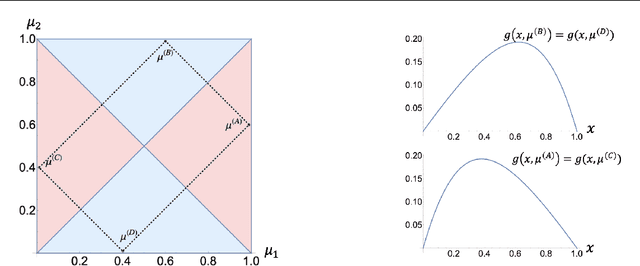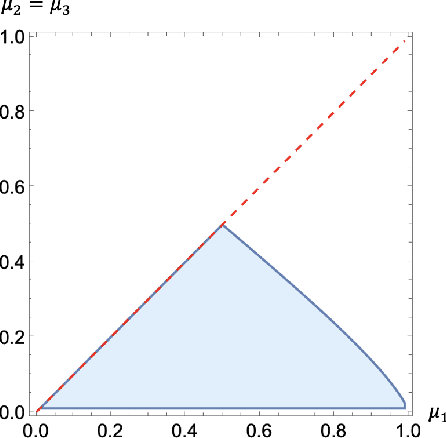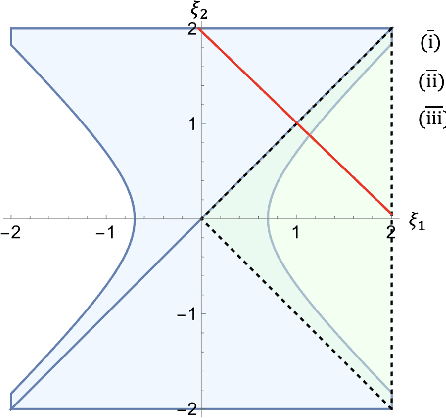Alexandre Proutiere
Adaptive Reinforcement Learning for Unobservable Random Delays
Jun 17, 2025Abstract:In standard Reinforcement Learning (RL) settings, the interaction between the agent and the environment is typically modeled as a Markov Decision Process (MDP), which assumes that the agent observes the system state instantaneously, selects an action without delay, and executes it immediately. In real-world dynamic environments, such as cyber-physical systems, this assumption often breaks down due to delays in the interaction between the agent and the system. These delays can vary stochastically over time and are typically unobservable, meaning they are unknown when deciding on an action. Existing methods deal with this uncertainty conservatively by assuming a known fixed upper bound on the delay, even if the delay is often much lower. In this work, we introduce the interaction layer, a general framework that enables agents to adaptively and seamlessly handle unobservable and time-varying delays. Specifically, the agent generates a matrix of possible future actions to handle both unpredictable delays and lost action packets sent over networks. Building on this framework, we develop a model-based algorithm, Actor-Critic with Delay Adaptation (ACDA), which dynamically adjusts to delay patterns. Our method significantly outperforms state-of-the-art approaches across a wide range of locomotion benchmark environments.
Policy Testing in Markov Decision Processes
May 21, 2025Abstract:We study the policy testing problem in discounted Markov decision processes (MDPs) under the fixed-confidence setting. The goal is to determine whether the value of a given policy exceeds a specified threshold while minimizing the number of observations. We begin by deriving an instance-specific lower bound that any algorithm must satisfy. This lower bound is characterized as the solution to an optimization problem with non-convex constraints. We propose a policy testing algorithm inspired by this optimization problem--a common approach in pure exploration problems such as best-arm identification, where asymptotically optimal algorithms often stem from such optimization-based characterizations. As for other pure exploration tasks in MDPs, however, the non-convex constraints in the lower-bound problem present significant challenges, raising doubts about whether statistically optimal and computationally tractable algorithms can be designed. To address this, we reformulate the lower-bound problem by interchanging the roles of the objective and the constraints, yielding an alternative problem with a non-convex objective but convex constraints. Strikingly, this reformulated problem admits an interpretation as a policy optimization task in a newly constructed reversed MDP. Leveraging recent advances in policy gradient methods, we efficiently solve this problem and use it to design a policy testing algorithm that is statistically optimal--matching the instance-specific lower bound on sample complexity--while remaining computationally tractable. We validate our approach with numerical experiments.
Model-free Low-Rank Reinforcement Learning via Leveraged Entry-wise Matrix Estimation
Oct 30, 2024Abstract:We consider the problem of learning an $\varepsilon$-optimal policy in controlled dynamical systems with low-rank latent structure. For this problem, we present LoRa-PI (Low-Rank Policy Iteration), a model-free learning algorithm alternating between policy improvement and policy evaluation steps. In the latter, the algorithm estimates the low-rank matrix corresponding to the (state, action) value function of the current policy using the following two-phase procedure. The entries of the matrix are first sampled uniformly at random to estimate, via a spectral method, the leverage scores of its rows and columns. These scores are then used to extract a few important rows and columns whose entries are further sampled. The algorithm exploits these new samples to complete the matrix estimation using a CUR-like method. For this leveraged matrix estimation procedure, we establish entry-wise guarantees that remarkably, do not depend on the coherence of the matrix but only on its spikiness. These guarantees imply that LoRa-PI learns an $\varepsilon$-optimal policy using $\widetilde{O}({S+A\over \mathrm{poly}(1-\gamma)\varepsilon^2})$ samples where $S$ (resp. $A$) denotes the number of states (resp. actions) and $\gamma$ the discount factor. Our algorithm achieves this order-optimal (in $S$, $A$ and $\varepsilon$) sample complexity under milder conditions than those assumed in previously proposed approaches.
Conformal Predictions under Markovian Data
Jul 21, 2024Abstract:We study the split Conformal Prediction method when applied to Markovian data. We quantify the gap in terms of coverage induced by the correlations in the data (compared to exchangeable data). This gap strongly depends on the mixing properties of the underlying Markov chain, and we prove that it typically scales as $\sqrt{t_\mathrm{mix}\ln(n)/n}$ (where $t_\mathrm{mix}$ is the mixing time of the chain). We also derive upper bounds on the impact of the correlations on the size of the prediction set. Finally we present $K$-split CP, a method that consists in thinning the calibration dataset and that adapts to the mixing properties of the chain. Its coverage gap is reduced to $t_\mathrm{mix}/(n\ln(n))$ without really affecting the size of the prediction set. We finally test our algorithms on synthetic and real-world datasets.
Model-Free Active Exploration in Reinforcement Learning
Jun 30, 2024Abstract:We study the problem of exploration in Reinforcement Learning and present a novel model-free solution. We adopt an information-theoretical viewpoint and start from the instance-specific lower bound of the number of samples that have to be collected to identify a nearly-optimal policy. Deriving this lower bound along with the optimal exploration strategy entails solving an intricate optimization problem and requires a model of the system. In turn, most existing sample optimal exploration algorithms rely on estimating the model. We derive an approximation of the instance-specific lower bound that only involves quantities that can be inferred using model-free approaches. Leveraging this approximation, we devise an ensemble-based model-free exploration strategy applicable to both tabular and continuous Markov decision processes. Numerical results demonstrate that our strategy is able to identify efficient policies faster than state-of-the-art exploration approaches
Low-Rank Bandits via Tight Two-to-Infinity Singular Subspace Recovery
Feb 24, 2024Abstract:We study contextual bandits with low-rank structure where, in each round, if the (context, arm) pair $(i,j)\in [m]\times [n]$ is selected, the learner observes a noisy sample of the $(i,j)$-th entry of an unknown low-rank reward matrix. Successive contexts are generated randomly in an i.i.d. manner and are revealed to the learner. For such bandits, we present efficient algorithms for policy evaluation, best policy identification and regret minimization. For policy evaluation and best policy identification, we show that our algorithms are nearly minimax optimal. For instance, the number of samples required to return an $\varepsilon$-optimal policy with probability at least $1-\delta$ typically scales as ${m+n\over \varepsilon^2}\log(1/\delta)$. Our regret minimization algorithm enjoys minimax guarantees scaling as $r^{7/4}(m+n)^{3/4}\sqrt{T}$, which improves over existing algorithms. All the proposed algorithms consist of two phases: they first leverage spectral methods to estimate the left and right singular subspaces of the low-rank reward matrix. We show that these estimates enjoy tight error guarantees in the two-to-infinity norm. This in turn allows us to reformulate our problems as a misspecified linear bandit problem with dimension roughly $r(m+n)$ and misspecification controlled by the subspace recovery error, as well as to design the second phase of our algorithms efficiently.
Best Arm Identification with Fixed Budget: A Large Deviation Perspective
Dec 19, 2023Abstract:We consider the problem of identifying the best arm in stochastic Multi-Armed Bandits (MABs) using a fixed sampling budget. Characterizing the minimal instance-specific error probability for this problem constitutes one of the important remaining open problems in MABs. When arms are selected using a static sampling strategy, the error probability decays exponentially with the number of samples at a rate that can be explicitly derived via Large Deviation techniques. Analyzing the performance of algorithms with adaptive sampling strategies is however much more challenging. In this paper, we establish a connection between the Large Deviation Principle (LDP) satisfied by the empirical proportions of arm draws and that satisfied by the empirical arm rewards. This connection holds for any adaptive algorithm, and is leveraged (i) to improve error probability upper bounds of some existing algorithms, such as the celebrated \sr (Successive Rejects) algorithm \citep{audibert2010best}, and (ii) to devise and analyze new algorithms. In particular, we present \sred (Continuous Rejects), a truly adaptive algorithm that can reject arms in {\it any} round based on the observed empirical gaps between the rewards of various arms. Applying our Large Deviation results, we prove that \sred enjoys better performance guarantees than existing algorithms, including \sr. Extensive numerical experiments confirm this observation.
Spectral Entry-wise Matrix Estimation for Low-Rank Reinforcement Learning
Oct 10, 2023Abstract:We study matrix estimation problems arising in reinforcement learning (RL) with low-rank structure. In low-rank bandits, the matrix to be recovered specifies the expected arm rewards, and for low-rank Markov Decision Processes (MDPs), it may for example characterize the transition kernel of the MDP. In both cases, each entry of the matrix carries important information, and we seek estimation methods with low entry-wise error. Importantly, these methods further need to accommodate for inherent correlations in the available data (e.g. for MDPs, the data consists of system trajectories). We investigate the performance of simple spectral-based matrix estimation approaches: we show that they efficiently recover the singular subspaces of the matrix and exhibit nearly-minimal entry-wise error. These new results on low-rank matrix estimation make it possible to devise reinforcement learning algorithms that fully exploit the underlying low-rank structure. We provide two examples of such algorithms: a regret minimization algorithm for low-rank bandit problems, and a best policy identification algorithm for reward-free RL in low-rank MDPs. Both algorithms yield state-of-the-art performance guarantees.
Sub-linear Regret in Adaptive Model Predictive Control
Oct 07, 2023Abstract:We consider the problem of adaptive Model Predictive Control (MPC) for uncertain linear-systems with additive disturbances and with state and input constraints. We present STT-MPC (Self-Tuning Tube-based Model Predictive Control), an online algorithm that combines the certainty-equivalence principle and polytopic tubes. Specifically, at any given step, STT-MPC infers the system dynamics using the Least Squares Estimator (LSE), and applies a controller obtained by solving an MPC problem using these estimates. The use of polytopic tubes is so that, despite the uncertainties, state and input constraints are satisfied, and recursive-feasibility and asymptotic stability hold. In this work, we analyze the regret of the algorithm, when compared to an oracle algorithm initially aware of the system dynamics. We establish that the expected regret of STT-MPC does not exceed $O(T^{1/2 + \epsilon})$, where $\epsilon \in (0,1)$ is a design parameter tuning the persistent excitation component of the algorithm. Our result relies on a recently proposed exponential decay of sensitivity property and, to the best of our knowledge, is the first of its kind in this setting. We illustrate the performance of our algorithm using a simple numerical example.
On Uniformly Optimal Algorithms for Best Arm Identification in Two-Armed Bandits with Fixed Budget
Sep 04, 2023



Abstract:We study the problem of best-arm identification with fixed budget in stochastic two-arm bandits with Bernoulli rewards. We prove that there is no algorithm that (i) performs as well as the algorithm sampling each arm equally (this algorithm is referred to as the {\it uniform sampling} algorithm) on all instances, and that (ii) strictly outperforms this algorithm on at least one instance. In short, there is no algorithm better than the uniform sampling algorithm. Towards this result, we first introduce the natural class of {\it consistent} and {\it stable} algorithms, and show that any algorithm that performs as well as the uniform sampling algorithm on all instances belongs to this class. The proof then proceeds by deriving a lower bound on the error rate satisfied by any consistent and stable algorithm, and by showing that the uniform sampling algorithm matches this lower bound. Our results provide a solution to the two open problems presented in \cite{qin2022open}.
 Add to Chrome
Add to Chrome Add to Firefox
Add to Firefox Add to Edge
Add to Edge